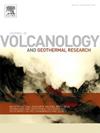Exposing electrical conductivity anomalies beneath Mount Erciyes, Cappadocia, Türkiye
IF 2.3
3区 地球科学
Q2 GEOSCIENCES, MULTIDISCIPLINARY
Journal of Volcanology and Geothermal Research
Pub Date : 2025-08-19
DOI:10.1016/j.jvolgeores.2025.108428
引用次数: 0
Abstract
Three-dimensional electrical conductivity models for Mount Erciyes, the most prominent stratovolcano at the Cappadocia Volcanic Province in Central Anatolia, Türkiye, were developed from magnetotellurics (MT) data collected at thirty-eight sounding locations. Analyses including electromagnetic impedance tensor and phase tensor calculations were employed to portray the conductivity variations, to reveal the dimensionality of the dataset and to detect the principal geo-electric strike direction in the area. Next, several trial models were developed including and excluding topography information as well as different starting models and other modeling parameters. Results achieved from all of the inverse calculations and particularly the final model suggested that (i) high electrical conductivity (<10 Ωm) values are obtained for multiple anomalies distributed beneath the complex reaching to depths of around 4–6 km from the summit, (ii) these anomalies coincide with the parasitic cones and the vents associated with the Mount Erciyes, (iii) the northeast-southwest trending faults that bound the Erciyes Basin and the wrench zone that cut across the main volcano complex act as barriers for the fluid flow.
揭露基耶省卡帕多西亚埃尔西耶斯山下的电导率异常
利用在基耶省中部安纳托利亚卡帕多西亚火山省采集的38个测深点大地电磁数据,建立了Erciyes火山的三维电导率模型。利用电磁阻抗张量和相位张量计算等分析方法描绘了电导率变化,揭示了数据集的维数,并检测了该地区的主要地电走向。其次,建立了包括地形信息和不包括地形信息以及不同初始模型和其他建模参数的几个试验模型。所有逆计算的结果,特别是最终模型的结果表明:(i)分布在复杂地下的多个异常获得了高电导率(<10 Ωm)值,到达距离山顶约4-6公里的深度,(ii)这些异常与寄生锥和与Erciyes火山相关的喷口相吻合。(3)束缚Erciyes盆地的东北-西南向断裂和切断主火山杂岩的扳手带是流体流动的屏障。
本文章由计算机程序翻译,如有差异,请以英文原文为准。
求助全文
约1分钟内获得全文
求助全文
来源期刊
CiteScore
5.90
自引率
13.80%
发文量
183
审稿时长
19.7 weeks
期刊介绍:
An international research journal with focus on volcanic and geothermal processes and their impact on the environment and society.
Submission of papers covering the following aspects of volcanology and geothermal research are encouraged:
(1) Geological aspects of volcanic systems: volcano stratigraphy, structure and tectonic influence; eruptive history; evolution of volcanic landforms; eruption style and progress; dispersal patterns of lava and ash; analysis of real-time eruption observations.
(2) Geochemical and petrological aspects of volcanic rocks: magma genesis and evolution; crystallization; volatile compositions, solubility, and degassing; volcanic petrography and textural analysis.
(3) Hydrology, geochemistry and measurement of volcanic and hydrothermal fluids: volcanic gas emissions; fumaroles and springs; crater lakes; hydrothermal mineralization.
(4) Geophysical aspects of volcanic systems: physical properties of volcanic rocks and magmas; heat flow studies; volcano seismology, geodesy and remote sensing.
(5) Computational modeling and experimental simulation of magmatic and hydrothermal processes: eruption dynamics; magma transport and storage; plume dynamics and ash dispersal; lava flow dynamics; hydrothermal fluid flow; thermodynamics of aqueous fluids and melts.
(6) Volcano hazard and risk research: hazard zonation methodology, development of forecasting tools; assessment techniques for vulnerability and impact.

 求助内容:
求助内容: 应助结果提醒方式:
应助结果提醒方式:


